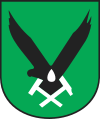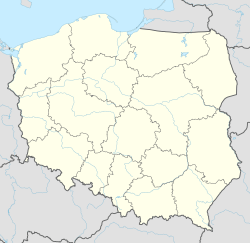Jastrzębie-Zdrój facts for kids
Jastrzębie-Zdrój (pronounced: YAS-trem-b-yeh ZDROOY) is a city in southern Poland. In 2021, about 86,632 people lived there. The city's name comes from two Polish words: jastrząb, which means "hawk," and zdrój, meaning "spa" or "spring."
From 1861 until the 20th century, Jastrzębie-Zdrój was a small village known for its healing spa. It was located in a region called Upper Silesia. The city officially became a "city" in 1963. Today, Jastrzębie-Zdrój is part of the Silesian Voivodeship. In the early 1980s, the city was a major place for workers' protests. These protests led to the creation of a famous Polish trade union called Solidarity.
Quick facts for kids
Jastrzębie-Zdrój
|
|||
|---|---|---|---|
|
Clockwise from top: Borynia Palace; Former Bracka Company Sanatorium; Drinking House; Sacred Heart of Jesus Church; Zdrojowy Park; Dąbrówka Hotel
|
|||
|
|||
| Motto(s):
Jastrzębie-Zdrój – city of youth, work and peace
|
|||
| Country | |||
| Voivodeship | |||
| County | city county | ||
| Established | 14th century | ||
| City rights | 1963 | ||
| Area | |||
| • Total | 85.44 km2 (32.99 sq mi) | ||
| Population
(31 December 2021)
|
|||
| • Total | 86,632 |
||
| Time zone | UTC+1 (CET) | ||
| • Summer (DST) | UTC+2 (CEST) | ||
| Postal code |
44-330 to 44-335, 44-268
|
||
| Area code(s) | +48 32 | ||
| Car plates | SJZ | ||
| Website | http://www.jastrzebie.pl | ||
Contents
History of Jastrzębie-Zdrój
The first records about this area are from around 1305. The city is made up of several older settlements. Its first name was Jastrzemb. The name, meaning 'hawk' in Polish, is linked to a legend about a black knight.
In the mid-1800s, people started digging for coal in the area. Instead, they found natural springs with iodine and bromine. These are good for health! In 1860, a count named Königsdorff bought the land. He suggested building a health resort.
So, in 1862, the health resort of Bad Königsdorff-Jastrzemb opened. Soon, it became one of the most popular health resorts in Europe.
In 1896, a Polish doctor named Mikołaj Witczak took over the health center. He helped it grow even more. Thanks to his smart ideas, Jastrzębie-Zdrój became a very popular and stylish health resort. Many new health facilities were built.
After World War I, in 1921, people in Silesia voted on whether to join Poland or Germany. About 85% of people in Jastrzębie-Zdrój voted for Poland. Many also fought in the Silesian uprisings to join Poland. Finally, in 1922, Jastrzębie-Zdrój became part of Poland.
The city's time as a health resort ended in the 1960s. This was because people started digging a lot of coking coal in the area. Within 12 years, five coal mines were built.
Jastrzębie-Zdrój is also famous in modern Polish history. In 1980, an important agreement called "the Jastrzębskie Agreement" was signed here. This agreement helped start big political and economic changes in Poland.
Population and City Layout
As of January 31, 2012, the city had 91,723 people. This means about 1,047.9 people live in each square kilometer. Jastrzębie-Zdrój is the 36th largest city in Poland. The number of people without jobs in Jastrzębie-Zdrój is lower than the average for Poland.
Jastrzębie-Zdrój is divided into 15 districts and 6 sołectwos. These are like smaller neighborhoods or villages within the city. Most districts are like suburbs. Some have many apartment buildings, creating large housing areas. Others are more like town centers.
- Arki Bożka (6,632 inhabitants)
- Barbary (10,185 inhabitants)
- Bogoczowiec (1,672 inhabitants)
- Chrobrego (5,042 inhabitants)
- Gwarków (8,126 inhabitants)
- Jastrzębie Górne i Dolne (4,369 inhabitants)
- Morcinka (4,534 inhabitants)
- Pionierów (11,210 inhabitants)
- Przyjaźń (4,718 inhabitants)
- Staszica (6,079 inhabitants)
- Tuwima (480 inhabitants)
- Tysiąclecia (3,242 inhabitants)
- Zdrój (7,682 inhabitants)
- Złote łany (1,118 inhabitants)
- Zofiówka (3,473 inhabitants)
Sołectwos:
- Borynia (1,918 inhabitants)
- Bzie (3,602 inhabitants)
- Moszczenica (3,026 inhabitants)
- Ruptawa (3,767 inhabitants)
- Skrzeczkowice (694 inhabitants)
- Szeroka (2,273 inhabitants)
Sports in Jastrzębie-Zdrój
Jastrzębie-Zdrój is home to several professional sports teams.
- Famous Clubs
- GKS Jastrzębie – A professional men's football (soccer) club.
- Jastrzębski Węgiel – A professional men's volleyball club. They have won the Polish Championship twice.
- JKH GKS Jastrzębie – A professional men's ice hockey club.
- Other Clubs
- BKS Jastrzębie – For boxing.
- UKH Białe Jastrzębie – For women's ice hockey.
- LKS Granica Ruptawa – For football.
- LKS Zryw Bzie – For football.
- LKS Hadex Szeroka – For football.
- Koka Jastrzębie – For judo.
- UKS Romi Jastrzębie – For women's handball.
Notable People from Jastrzębie-Zdrój
Many interesting people have come from Jastrzębie-Zdrój:
- Henryk Sławik (1894–1944) – A Polish politician and social worker. During World War II, he helped save over 30,000 Polish refugees, including 5,000 Polish Jews, by giving them fake passports.
- Urszula Wybraniec-Skardowska (born 1940) – A Polish logician, someone who studies how we reason.
- Krystian Lupa (born 1943) – A famous Polish theatre director, designer, and writer.
- Magdalena Lewy-Boulet (born 1973) – An American athlete.
- Marcin Radzewicz (born 1980) – A Polish footballer.
- Dariusz Kłus (born 1981) – A Polish footballer.
- Łukasz Pielorz (born 1983) – A Polish footballer.
- Kamil Glik (born 1988) – A Polish footballer.
- Michał Skóraś (born 2000) – A Polish footballer.
Twin Towns – Sister Cities
Twin towns are cities that form a special bond to promote cultural and economic ties. Jastrzębie-Zdrój is twinned with:
 Borshchiv, Ukraine (2017)
Borshchiv, Ukraine (2017) Havířov, Czech Republic (2007)
Havířov, Czech Republic (2007) Ibbenbüren, Germany (2007)
Ibbenbüren, Germany (2007) Karviná, Czech Republic (1995)
Karviná, Czech Republic (1995) Prievidza, Slovakia (2009)
Prievidza, Slovakia (2009) Tourcoing, France (2007)
Tourcoing, France (2007)
Images for kids
See also
 In Spanish: Jastrzębie-Zdrój para niños
In Spanish: Jastrzębie-Zdrój para niños













